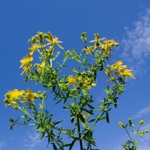Hypericum perforatum
Common St John's wort Σπαθόχορτο ή Βάλσαμο

Apocynaceae - family Dicot.
Hypericum perforatum
Common St John's wort Σπαθόχορτο ή Βάλσαμο

Apocynaceae - family Dicot.
The bright yellow flowers of St. John's wort, Hypericum perforatum, are abundant in fallow fields and olive groves amongst the summer grasses. They flower later than the other form of St. John"s wort, H. empetrifolium, which is also common in Skopelos.
With multiple erect branched stems, there can have up to 100 flowers on each plant. The flowers have five yellow petals surrounding a myriad of yellow stamens. The petals are edged with black dots and the leaves are peppered with translucent spots, which give the appearance of perforations. These are glands which produce biologically active substances; when the petals are crushed, they exude blood-red juice.

Medicinal properties of St. John's Wort
The medicinal properties of St. John's wort have been recognised since ancient times. All members of the Hypericum genus contain a variety of chemical substances including hypericin which is red in colour. H. perforatum, has the highest concentration of active substances. Extracts in oil or alcohol can be used for scratches, grazes and bruises and have have proven anti-bacterial activity. The Knights of St. John used it to heal wounds during the crusades of the 16th century and is still used as a folk remedy today.
The dried leaves and flowers are used to make a soothing tea and extracts are used in herbal treatment of low mood and anxiety.
Like any other active medication it does have side effects, occasionally serious.
H.perforatum continues to be used on Skopelos:
Click below to see the interesting and infomative website:

